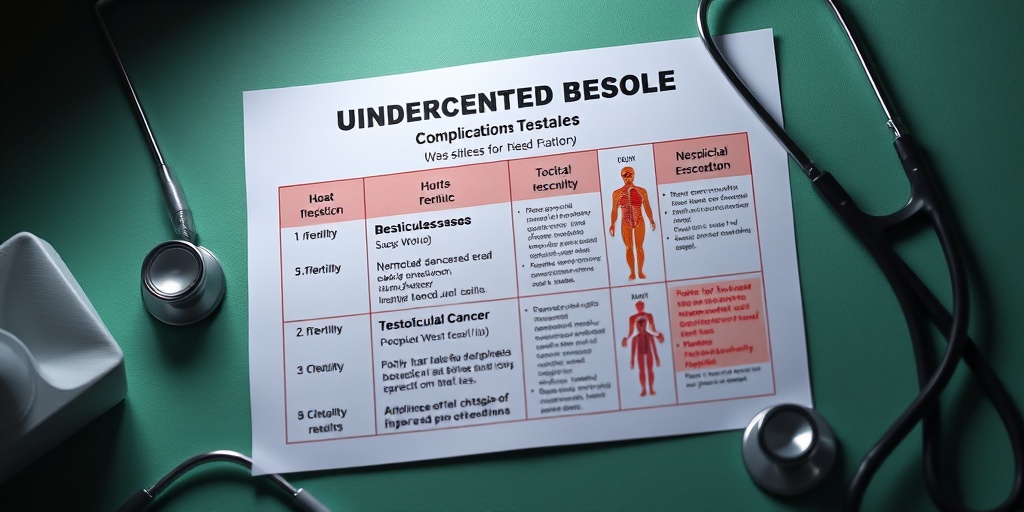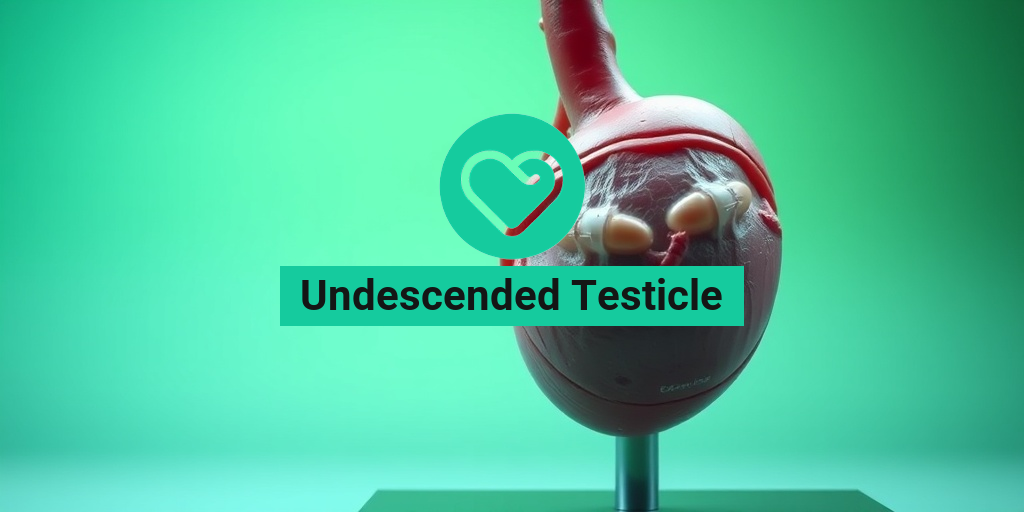What Is an Undescended Testicle?
An undescended testicle, medically known as cryptorchidism, is a condition where one or both testicles fail to move down into the scrotum before birth. Typically, testicles develop in the abdomen of a fetus and descend into the scrotum during the last few months of pregnancy. However, in some cases, this descent does not occur, leading to an undescended testicle.
Understanding the Condition
Undescended testicles are relatively common, affecting about 3% of full-term male infants and up to 30% of premature infants. The condition can occur in various forms:
- Unilateral Cryptorchidism: One testicle is undescended.
- Bilateral Cryptorchidism: Both testicles are undescended.
While the exact cause of undescended testicles is not always clear, several factors may contribute, including:
- Genetic predisposition
- Hormonal imbalances
- Environmental factors
Why Is It Important to Address?
Addressing an undescended testicle is crucial for several reasons:
- Fertility Issues: If left untreated, an undescended testicle can lead to fertility problems later in life.
- Increased Cancer Risk: There is a higher risk of testicular cancer in individuals with undescended testicles.
- Hernia Risk: An undescended testicle can increase the risk of inguinal hernias.
For these reasons, early diagnosis and treatment are essential. If you suspect that your child has an undescended testicle, consulting a healthcare professional is vital.
Symptoms of Undescended Testicle
Identifying an undescended testicle can sometimes be straightforward, especially in infants. However, symptoms may vary based on age and the specific circumstances of the condition.
Signs in Infants and Young Children
In infants and young children, the primary symptom is the absence of one or both testicles in the scrotum. Parents may notice:
- Asymmetry: The scrotum may appear smaller or less developed on the side of the undescended testicle.
- Palpable Testicle: In some cases, the testicle may be felt in the groin area or abdomen.
Symptoms in Older Children and Adults
In older children and adults, symptoms may not be as apparent. However, some individuals may experience:
- Pain or Discomfort: Some may feel discomfort in the groin or abdomen.
- Swelling: There may be swelling in the groin area, especially if a hernia is present.
- Fertility Concerns: Men with undescended testicles may face challenges with fertility, which can be a significant concern.
When to Seek Medical Attention
If you notice any signs of an undescended testicle in your child or experience symptoms as an adult, it’s essential to seek medical advice. A healthcare provider can perform a physical examination and may recommend further tests, such as an ultrasound, to confirm the diagnosis.
For comprehensive information and resources about undescended testicles, consider visiting Yesil Health AI, where you can find evidence-based health answers tailored to your needs.
In conclusion, understanding what an undescended testicle is and recognizing its symptoms can lead to timely intervention and treatment, ensuring better health outcomes. If you have concerns, don’t hesitate to reach out to a healthcare professional! 🩺

Causes of Undescended Testicle
An undescended testicle, also known as cryptorchidism, occurs when one or both testicles fail to move down into the scrotum before birth. Understanding the causes of this condition is crucial for parents and caregivers. Here are some of the primary factors that contribute to undescended testicles:
Genetic Factors
Genetics play a significant role in the development of undescended testicles. If there is a family history of this condition, the likelihood of occurrence increases. Certain genetic syndromes, such as Down syndrome or Klinefelter syndrome, are also associated with a higher risk of cryptorchidism.
Hormonal Influences
During fetal development, hormones are responsible for the descent of the testicles. Any disruption in hormonal levels, particularly testosterone, can lead to undescended testicles. Conditions affecting the endocrine system may also contribute to this issue.
Prematurity and Low Birth Weight
Babies born prematurely or with low birth weight are at a greater risk of having undescended testicles. The testicles typically descend during the last few months of pregnancy, so if a baby is born early, this process may not be completed.
Environmental Factors
Exposure to certain environmental factors during pregnancy may increase the risk of undescended testicles. For instance, maternal smoking, alcohol consumption, and exposure to endocrine-disrupting chemicals can interfere with normal fetal development.
Other Medical Conditions
Some medical conditions can also contribute to the occurrence of undescended testicles. Conditions such as hypospadias (a birth defect affecting the urethra) or abnormalities in the abdominal wall can interfere with the normal descent of the testicles.
Risk Factors for Undescended Testicle
Identifying the risk factors associated with undescended testicles can help in early detection and intervention. Here are some key risk factors to consider:
Family History
A family history of undescended testicles significantly increases the risk. If a sibling or parent had this condition, the chances of it occurring in a newborn are higher.
Gestational Age
As mentioned earlier, premature infants are at a higher risk. Babies born before 37 weeks of gestation are more likely to have undescended testicles compared to full-term infants.
Birth Weight
Low birth weight is another critical risk factor. Infants weighing less than 5.5 pounds (2.5 kg) at birth are more susceptible to this condition.
Maternal Health and Lifestyle
The health and lifestyle choices of the mother during pregnancy can impact the likelihood of undescended testicles. Factors such as smoking, drug use, and poor nutrition can contribute to developmental issues in the fetus.
Multiple Births
Twins or higher-order multiples are at an increased risk of having undescended testicles. The shared space in the womb can lead to complications in the normal descent of the testicles.
Other Congenital Anomalies
Infants with other congenital anomalies, such as those affecting the urinary tract or genitalia, may also have a higher incidence of undescended testicles. These conditions can interfere with the normal anatomical development necessary for testicular descent.
Understanding the causes and risk factors associated with undescended testicles is essential for parents and healthcare providers. Early diagnosis and intervention can lead to better outcomes for affected individuals. If you suspect your child may have this condition, consult a healthcare professional for guidance and potential treatment options. 🩺

Diagnosis of Undescended Testicle
Diagnosing an undescended testicle, also known as cryptorchidism, is a crucial step in ensuring the health and well-being of affected individuals. This condition occurs when one or both testicles fail to descend into the scrotum before birth. Early diagnosis is essential, as it can lead to complications if left untreated.
Physical Examination
The primary method for diagnosing an undescended testicle is through a thorough physical examination. During this examination, a healthcare provider will:
- Check the scrotum for the presence of one or both testicles.
- Assess the size and shape of the scrotum.
- Palpate the inguinal canal (the passage in the lower abdomen) to locate any undescended testicle.
In many cases, the testicle may be found in the inguinal canal or may be absent altogether. If the testicle is not palpable, further imaging studies may be necessary.
Imaging Studies
If the physical examination does not provide a clear diagnosis, healthcare providers may recommend imaging studies. These can include:
- Ultrasound: This non-invasive imaging technique uses sound waves to create images of the testicles and surrounding structures. It can help locate an undescended testicle and assess its condition.
- MRI: In some cases, a magnetic resonance imaging (MRI) scan may be used to provide detailed images of the abdominal cavity and locate the testicle.
These imaging studies are particularly useful in older children and adults, where the diagnosis may not be as straightforward.
Referral to a Specialist
If an undescended testicle is diagnosed, a referral to a pediatric urologist or a urologist specializing in male reproductive health may be necessary. These specialists can provide further evaluation and discuss treatment options, including undescended testicle surgery, if required.
Complications of Undescended Testicle
Leaving an undescended testicle untreated can lead to several complications that may affect both physical health and psychological well-being. Understanding these potential issues is vital for parents and individuals affected by this condition.
Infertility Risks
One of the most significant concerns associated with an undescended testicle is the risk of infertility. Testicles that remain in the abdomen are exposed to higher temperatures than those in the scrotum, which can adversely affect sperm production and quality. Studies have shown that men with a history of undescended testicles may have:
- A lower sperm count.
- Increased chances of abnormal sperm morphology.
- Higher rates of infertility.
Early surgical intervention can help mitigate these risks and improve fertility outcomes.
Increased Cancer Risk
Another serious complication is the increased risk of testicular cancer. Men with a history of undescended testicles have a higher likelihood of developing testicular cancer later in life. The risk is particularly pronounced if the condition is not corrected during childhood. Regular self-examinations and monitoring by a healthcare provider are essential for early detection.
Psychological Impact
The psychological effects of having an undescended testicle should not be overlooked. Individuals may experience:
- Feelings of embarrassment or shame.
- Low self-esteem, particularly during adolescence.
- Anxiety about body image and sexual health.
Addressing these concerns through counseling and support can be beneficial for affected individuals.
Other Complications
In addition to the above, other complications may arise, including:
- Testicular torsion: This is a painful condition where the testicle twists, cutting off its blood supply. It can occur more frequently in undescended testicles.
- Hernias: An undescended testicle can be associated with inguinal hernias, which occur when abdominal contents protrude through a weak spot in the abdominal wall.
Recognizing and addressing these complications early can significantly improve health outcomes for individuals with an undescended testicle. Regular check-ups and open communication with healthcare providers are key to managing this condition effectively. 🩺

Treatment Options for Undescended Testicle
An undescended testicle, also known as cryptorchidism, is a condition where one or both testicles fail to descend into the scrotum before birth. This condition is relatively common, affecting about 3% of full-term male infants. Fortunately, there are effective treatment options available to address this issue.
Observation and Monitoring
In many cases, especially for infants, doctors may recommend a period of observation. This is because some undescended testicles may descend on their own within the first few months of life. Regular check-ups are essential during this time to monitor the testicle’s position and ensure that no complications arise.
Surgical Intervention
If the testicle does not descend naturally by the age of 6 months to 1 year, surgical intervention is often necessary. The most common procedure is called orchidopexy, where the testicle is surgically moved into the scrotum and secured in place. This surgery is typically performed under general anesthesia and is considered safe and effective.
- Timing: Ideally, orchidopexy should be performed before the child reaches 18 months of age to minimize potential complications.
- Recovery: Post-surgery, most children can return to normal activities within a few days, although some restrictions may apply for a short period.
Hormonal Treatment
In certain cases, hormonal therapy may be considered as an alternative to surgery. Medications such as human chorionic gonadotropin (hCG) can stimulate the testicles to descend. However, this approach is less common and is usually reserved for specific situations where surgery may not be the best option.
Potential Complications
Leaving an undescended testicle untreated can lead to several complications, including:
- Infertility: The higher temperature in the abdomen can affect sperm production.
- Testicular Cancer: There is an increased risk of cancer in undescended testicles, particularly if not treated.
- Torsion: An undescended testicle is more prone to twisting, which can cause severe pain and require emergency treatment.
Preventive Measures and Outlook
While there are no guaranteed ways to prevent an undescended testicle, understanding the risk factors and maintaining a healthy pregnancy can help reduce the likelihood of this condition.
Understanding Risk Factors
Several factors may increase the risk of an undescended testicle, including:
- Premature Birth: Babies born prematurely are at a higher risk.
- Low Birth Weight: Infants with a low birth weight may also be more susceptible.
- Family History: A family history of undescended testicles can increase risk.
Healthy Pregnancy Practices
For expectant mothers, adopting healthy practices during pregnancy can contribute to the overall health of the baby. Here are some tips:
- Avoid Smoking: Smoking during pregnancy is linked to various complications, including undescended testicles.
- Maintain a Balanced Diet: A nutritious diet supports fetal development.
- Regular Prenatal Care: Regular check-ups can help monitor the health of both mother and baby.
Long-Term Outlook
The long-term outlook for children with an undescended testicle is generally positive, especially when treated early. Most boys who undergo surgery will have normal testicular function and fertility later in life. Regular follow-ups with a healthcare provider are essential to monitor any potential issues that may arise.
In conclusion, while an undescended testicle can pose risks, effective treatment options and preventive measures can significantly improve outcomes. If you suspect your child may have this condition, consult a healthcare professional for guidance and support. 🩺

Frequently Asked Questions about Undescended Testicle
What is an Undescended Testicle?
An undescended testicle is a condition where one or both testicles fail to move down into the scrotum before birth. This can lead to various complications if not addressed properly.
What are the symptoms of an Undescended Testicle?
The primary symptom of an undescended testicle is the absence of one or both testicles in the scrotum. In some cases, there may be swelling or discomfort in the groin area.
How is an Undescended Testicle diagnosed?
Diagnosis typically involves a physical examination by a healthcare provider. In some cases, imaging tests may be used to locate the testicle if it is not palpable.
What are the treatment options for an Undescended Testicle?
Treatment usually involves surgery, known as orchidopexy, to move the testicle into the scrotum. This is often recommended if the testicle has not descended by the age of 6 months to 1 year.
Can an Undescended Testicle affect fertility?
Yes, an undescended testicle can impact fertility if not treated. The higher temperature in the abdomen can affect sperm production and quality.
Is surgery for an Undescended Testicle safe?
Yes, undescended testicle surgery is generally safe and effective. Most children recover quickly and can return to normal activities within a few weeks.
What is the recovery time after surgery?
Recovery time can vary, but most children can resume normal activities within 1 to 2 weeks after undescended testicle surgery.
Can adults have an Undescended Testicle?
While undescended testicles are typically diagnosed in infancy, some men may discover they have an undescended testicle later in life, such as at age 25. It is important to consult a healthcare provider for evaluation and potential treatment.
What are the long-term effects of an Undescended Testicle?
If treated early, most individuals do not experience significant long-term effects. However, untreated cases may lead to complications such as infertility or testicular cancer.
Are there any risks associated with leaving an Undescended Testicle untreated?
Yes, leaving an undescended testicle untreated can increase the risk of infertility, testicular torsion, and cancer. Early intervention is crucial for optimal outcomes.
Can dogs have an Undescended Testicle?
Yes, undescended testicles can also occur in dogs. This condition is similar to that in humans and may require surgical intervention.
What is the ICD-10 code for an Undescended Testicle?
The ICD-10 code for an undescended testicle is Q53. This code is used for medical billing and documentation purposes.




